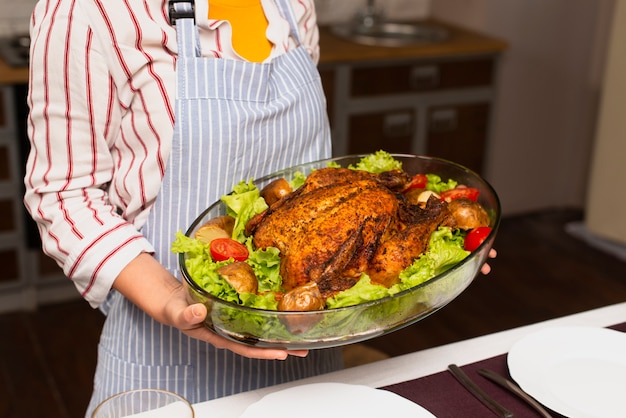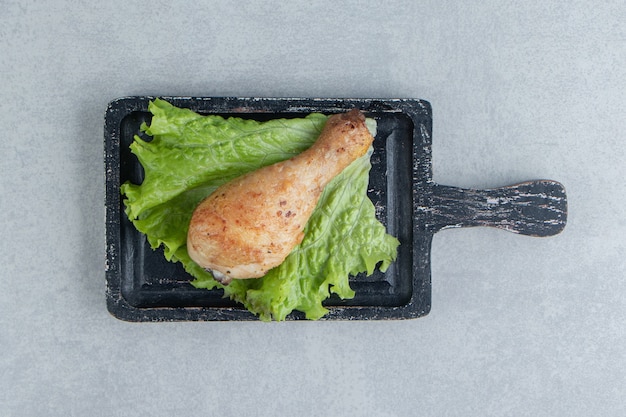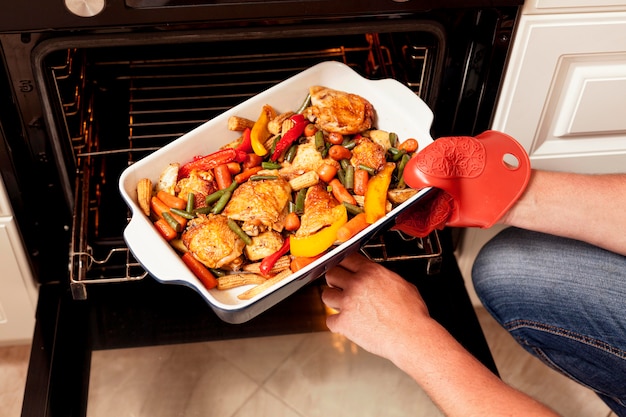chicken breasts. They’re a staple in so many kitchens, a blank canvas for countless delicious dishes. But let's be honest, they can also be a bit of a culinary challenge. Overcook them by even a minute and they go from tender and juicy to dry and rubbery – a real tragedy in the making!
I've been there, battling with dry, disappointing chicken breasts more times than I care to admit. But then, I stumbled upon a simple secret – a game-changer that transformed my chicken breast experience. With this method, I finally unlocked the key to juicy, flavorful, and perfectly cooked oven-baked chicken breasts, every time.
This isn't just another chicken breast recipe. It's a journey, a quest for the perfect result. I'm spilling the beans on all my tried-and-tested tips and tricks, from prepping the chicken to choosing the right temperature, to mastering the art of resting. We'll even explore some creative flavour combinations that'll make you forget all about those boring, bland chicken dinners. So, get ready to elevate your chicken game!
(Part 1) The Pre-Game: Choosing and Prepping Your Chicken

Let's start with the foundation of your delicious chicken breast journey – choosing the right chicken. Forget those watery, uninspiring supermarket offerings. We're going for quality! boneless, skinless chicken breasts are your go-to, but if you're feeling adventurous, bone-in breasts can bring a lovely depth of flavour.
When you're picking your chicken, look for plump, firm breasts with a healthy, even colour. Avoid those that look watery or have an off-putting odour. My personal preference? Fresh chicken from the local butcher, but if you're using supermarket chicken, give it a good rinse and pat it dry with kitchen paper. This little step helps to remove any excess moisture and sets the stage for a beautifully golden crust.
The Importance of Patting Dry: More Than Just a Fuss
Patting dry might seem like a minor detail, but it's a crucial step for juicy, crispy chicken. When you leave moisture on the surface of the chicken, it traps steam during cooking, preventing the skin from getting crispy and creating a soggy texture. By patting dry, you’re ensuring the heat goes straight into the meat, delivering a delicious golden crust and a wonderfully juicy interior.
(Part 2) Getting Your Chicken Ready for the Oven: Seasoning and Marinade Magic

Now that you've got your chicken prepped and ready to go, it's time to get creative! Seasoning and marinades can elevate a simple chicken breast into a culinary masterpiece. The possibilities are truly endless! I love experimenting with different flavour profiles, and I’m always on the lookout for new combinations.
Simple Seasoning for a Classic Flavour: Sometimes Less is More
If you're looking for a quick and easy option, salt and pepper are your best friends. I'm a firm believer in using freshly ground black pepper – it adds a depth of flavour that you just can't get from pre-ground. And a pinch of smoked paprika? It adds a smoky depth that truly elevates the simple flavours. Just rub the seasoning all over the chicken, making sure to get into all the nooks and crannies. It's a classic for a reason!
Flavour Boosters: Herbs and Spices to Unleash the Magic
For a little extra flavour magic, herbs and spices are your secret weapon. Garlic powder, onion powder, and dried oregano are staples in my kitchen. They add a lovely depth of flavour and aroma that instantly transforms your chicken. If you're feeling adventurous, a pinch of cayenne pepper or chili flakes adds a touch of heat for those who like things spicy. Remember, it's all about experimenting and finding what you love.
Marinade Magic: Infusing Your Chicken with Flavorful Bliss
Marinade is your secret weapon for juicy, flavorful chicken. It not only adds flavour but also helps to tenderize the meat. The possibilities are endless, but here are a few of my favourite marinade recipes to get you started:
- Citrus Burst: Mix together olive oil, lemon juice, garlic, and fresh herbs like rosemary and thyme. The citrusy brightness and fragrant herbs create a flavour explosion that's both refreshing and delicious.
- Mediterranean Delight: Combine olive oil, red wine vinegar, oregano, garlic, and a pinch of red pepper flakes. This combination takes you straight to a sunny Mediterranean kitchen, with a tangy, earthy flavour that's perfect for summer.
- Sweet and Spicy: Mix soy sauce, honey, ginger, garlic, and a touch of sriracha or gochujang. This sweet and spicy marinade delivers a burst of flavour that's both addictive and exciting.
Once you've chosen your marinade, place the chicken breasts in a sealed container or a zip-lock bag and let them soak up all that flavour for at least 30 minutes. For the best results, marinate for a few hours or even overnight. This gives the flavours time to really penetrate the meat, creating a delicious explosion of taste when you take that first bite.
(Part 3) Getting the Oven Ready: The Importance of Temperature and Time

Now that your chicken is prepped and ready to go, it's time to focus on the oven. We need to find that sweet spot – the perfect temperature and cooking time to ensure juicy, perfectly cooked chicken breasts.
The Optimal Oven Temperature: Finding the Perfect Balance
My go-to temperature for oven-baked chicken breasts is 375°F (190°C). It's the perfect balance: hot enough to cook the chicken through without drying it out.
Cooking Time: It's All About the Size of Your Chicken
The cooking time for chicken breasts depends on their size. A good rule of thumb is to cook them for 20-25 minutes for a medium-sized breast. But here's where things get a bit tricky. Different ovens have different heating characteristics, and every chicken breast is unique.
The meat thermometer: Your Chicken's Best Friend
To ensure perfectly cooked chicken, I always recommend using a meat thermometer. It's the most reliable way to check the internal temperature, which should be 165°F (74°C) for safe consumption. Simply insert the thermometer into the thickest part of the chicken breast.
But if you're a "set it and forget it" kind of person, don't worry, we'll talk about some foolproof ways to avoid overcooking your chicken in a bit.
(Part 4) The Baking Process: Putting Your Chicken in the Oven
Alright, it's the moment of truth! Time to put your prepped chicken in the oven. This is where the excitement begins, but it's also where a few crucial details come into play.
The Importance of Space: Give Your Chicken Room to Breathe
For perfectly cooked chicken breasts, they need enough space to breathe. If you're baking multiple breasts, arrange them in a single layer on a baking sheet. Make sure they're not touching, otherwise, they'll steam instead of roast, resulting in a less than ideal texture.
The Benefits of a Baking Dish: For a More Even Cooking Experience
If you have a smaller oven or simply prefer a more even cooking process, a baking dish is your friend. It helps to distribute heat more evenly and prevents the chicken from drying out. Just make sure the dish is oven-safe and big enough to hold your chicken breasts comfortably.
The Magic of a Basting Brush: Adding Moisture and Flavor
Here's a little trick I learned from my grandmother, a true culinary maestro – basting the chicken. It's a simple yet effective technique that ensures juicy, tender chicken. While your chicken is baking, use a basting brush to generously apply melted butter or oil to the top. This keeps the chicken moist and helps it to brown beautifully.
(Part 5) The Crucial Rest: Letting Your Chicken Relax and Redistribute Juices
The moment you've been waiting for – your chicken is done! But wait, don't rush to carve it up just yet. This is where the magic of resting comes in, a crucial step that often gets overlooked.
Why Resting is Essential: A Culinary Magic Trick
Resting the chicken after cooking allows the juices to redistribute evenly throughout the meat. This results in a more tender and juicy final product. If you don't rest the chicken, the juices will run out when you slice it, leading to a dry, disappointing dish.
How Long to Rest: Give Your Chicken Time to Relax
A good rule of thumb is to rest the chicken for 10-15 minutes before slicing. Cover it loosely with foil to keep it warm and prevent it from drying out. This time will allow the juices to redistribute throughout the meat, giving you the perfect, juicy chicken breast.
(Part 6) The Final Touches: Adding Some Extra Flair
Now, you've got your juicy, perfectly cooked chicken breasts. But let's not stop there. It's time to take things to the next level and add some extra flair that will make your chicken breasts even more irresistible.
Finishing Touches: Elevate Your Chicken Game
Here are a few ideas for finishing touches that will take your chicken breasts from good to great:
- Lemon and Herbs: Squeeze some lemon juice over the chicken and scatter fresh herbs like parsley, dill, or chives. The citrusy brightness and fresh herbs add a touch of vibrancy that complements the chicken beautifully.
- Garlic Butter: Mix melted butter with minced garlic and drizzle it over the chicken. The rich, garlicky flavour adds a luxurious touch that will make your chicken unforgettable.
- Glaze: A sweet and sticky glaze can add a touch of indulgence to your chicken. Try a honey-soy glaze, a maple-bourbon glaze, or a balsamic glaze. Each glaze adds a unique flavor profile and a beautiful, glossy finish that will make your chicken stand out.
- crispy skin: If you're using chicken breasts with skin, you can get a crispy, delicious skin by broiling the chicken for a few minutes at the end of the cooking time. Just be careful not to burn it! The crispy skin adds a delightful textural contrast and a burst of flavour that's worth the extra effort.
(Part 7) Chicken Breast Masterclass: Creative Combinations
Okay, you've got the basics down – but let's get creative! Here are a few delicious ways to use your juicy oven-baked chicken breasts to create mouthwatering meals.
Chicken Caesar Salad: A Classic for a Reason
A classic for a reason! Slice your chicken breasts into strips, toss them with your favourite Caesar dressing, and top with crunchy romaine lettuce, Parmesan cheese, and croutons. It's a satisfying and flavourful salad that's always a crowd-pleaser.
Chicken and Avocado Wrap: Light and Healthy Goodness
A light and healthy lunch option. Slice your chicken breast and layer it with avocado, lettuce, tomato, and a dollop of Greek yogurt or hummus. Wrap it up in a whole-wheat tortilla and you've got a delicious and nutritious meal.
Chicken with Roasted Vegetables: Simple and Satisfying
A simple and satisfying meal. Roast your chicken breasts alongside seasonal vegetables like broccoli, carrots, peppers, and onions. The roasting process brings out the natural sweetness of the vegetables, creating a beautiful balance of flavours.
Chicken Stir-Fry: A Quick and Flavorful Meal
Slice your chicken breasts into bite-sized pieces and stir-fry them with your favourite vegetables and sauce. You can use any vegetables you like, from bell peppers and onions to broccoli and carrots. Add a splash of your favourite sauce, whether it's soy sauce, teriyaki sauce, or a sweet and sour sauce, and you've got a quick and flavourful meal.
Chicken Pot Pie: comfort food at Its Finest
A comforting and hearty meal. Chop your chicken breasts and combine them with a creamy sauce, vegetables, and a flaky pastry crust. The combination of textures and flavours is simply irresistible.
Chicken Quesadillas: Easy and Delicious for weeknight dinners
Quick and easy for a weeknight dinner. Slice your chicken breasts and layer them on tortillas with cheese, salsa, and your favourite toppings. It's a versatile dish that can be customized to suit your taste.
(Part 8) The Big Question: How To Tell If My Chicken is Done?
You've followed all the steps, but you're still wondering – is it really cooked through? No worries, here are a few ways to make sure your chicken is perfectly cooked.
The Touch Test: A Quick and Easy Method
This is a quick and easy method. Simply press the chicken with your finger. If it feels firm and springs back, it's cooked. If it feels soft and jiggly, it needs a bit more time in the oven.
The Internal Temperature Test: The Most Reliable Method
The most reliable method is to use a meat thermometer. Insert the thermometer into the thickest part of the chicken breast. The temperature should be 165°F (74°C).
The Juice Test: Checking the Color of the Juices
Cut into the thickest part of the chicken breast. If the juices run clear, it's cooked. If the juices are pink, it needs a bit more time in the oven.
(Part 9) Avoiding Overcooked Chicken: My Top Tips
We've all been there – overcooked, dry chicken. But fear not, there are ways to avoid this culinary disaster.
Don't Overcrowd the Oven: Give Your Chicken Space
Make sure your chicken breasts have enough space to cook evenly. If you're baking multiple breasts, arrange them in a single layer on a baking sheet.
Don't Overcook It: Use Your Meat Thermometer Wisely
Use a meat thermometer to check the internal temperature of the chicken. The temperature should be 165°F (74°C). If you're unsure, it's always better to err on the side of undercooked. You can always pop it back in the oven for a few more minutes if needed.
Rest It: Let Your Chicken Relax
Letting your chicken rest after cooking is crucial for achieving juicy, tender meat. This allows the juices to redistribute throughout the meat, resulting in a more delicious final product.
Choose the Right Cut: chicken thighs for a More Forgiving Option
If you're prone to overcooking chicken, consider using chicken thighs. They're naturally more moist and forgiving than chicken breasts, making them a great option for those who are still mastering the art of oven-baked chicken.
(Part 10) FAQs: chicken breast cooking Conundrums Solved
Now that you've got all the tips and tricks, let's tackle some common chicken breast questions.
1. Can I Marinate Chicken Breast Overnight?
Absolutely! Marinating overnight is a great way to give the flavours a chance to really penetrate the meat. Just make sure you store the chicken in the fridge and keep it covered.
2. Can I Cook frozen chicken Breast?
It's not ideal, but you can cook frozen chicken breast. Just add an extra 5-10 minutes to the cooking time. However, it's best to thaw the chicken thoroughly in the fridge before cooking for the best results.
3. What Happens If I Overcook chicken breast?
If you overcook chicken breast, it will become dry and tough. Unfortunately, there's no way to undo overcooking, but you can try to salvage it by adding a moist sauce or gravy.
4. How Do I Reheat Chicken Breast?
The best way to reheat chicken breast is to do so in a preheated oven at 350°F (175°C) for about 10-15 minutes. You can also reheat it in the microwave, but it might not be as juicy.
5. How Long Can I Store Cooked Chicken Breast in the Fridge?
Cooked chicken breast can be stored in the fridge for up to 3-4 days. Make sure to refrigerate it properly in an airtight container or wrap it tightly in plastic wrap.
(Part 11) Final Thoughts: Embrace the Chicken Breast Journey
And there you have it – my guide to juicy, perfect oven-baked chicken breasts. I hope this journey has inspired you to experiment with different flavours and techniques. Remember, cooking is all about finding what you love and having fun. So go forth, conquer the chicken breast, and enjoy your culinary adventures!
Everyone is watching

How to Cook Frozen Lobster Tails Perfectly: A Step-by-Step Guide
RecipesLobster. Just the word conjures up images of lavish meals, special occasions, and a taste of luxury. But let's...

Pigs in a Blanket Cooking Time: How Long to Bake for Perfect Results
RecipesAh, pigs in a blanket. Just the name conjures up images of those delightful little parcels of crispy pastry en...

Pork Fillet Cooking Time: How Long to Cook It Perfectly
RecipesPork fillet, or tenderloin as it's sometimes called, is a real favourite in our house. It's so versatile, and...

The Ultimate Guide to Tender, Juicy Pulled Pork
RecipesRight, let's talk pulled pork. It's one of those dishes that just screams "comfort food," doesn't it? I mean...

The Ultimate Guide to Cooking Sweet Potatoes: From Roasting to Mashing
RecipesSweet potatoes. Just the name conjures up images of warm, comforting dishes, bursts of vibrant color, and a to...
